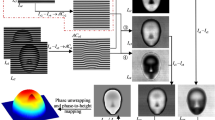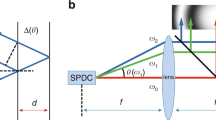Abstract
Coherent optical techniques of fringe multiplication can be used to enhance the sensitivity of moiré measurements. However, for some coherent optical-processing systems, the significance of the resulting interference pattern is influenced by the characteristics of the gratings being processed. Analysis of one commonly used system for fringe multiplication involving two bar and space amplitude gratings reveals that accuracy of displacements and strains calculated from a fringe pattern is very sensitive to the transmission ratios of the gratings being processed. For variations of the transmission ratio of only 10 percent from the ideal case of 50 percent, the interference patterns produced by optical processing no longer correspond to multiplied moiré-fringe patterns.
Similar content being viewed by others
Abbreviations
- a :
-
diffraction order of first diffraction in order sequence
- d i :
-
distance along optical axis
- e d :
-
relative displacement error
- e s :
-
percent error in strain
- F():
-
field amplitude in focal plane of first lens
- f i :
-
focal length of lensi
- f :
-
grating frequency (l/mm)
- ℱ{}{}:
-
Fourier transform
- g():
-
field amplitude in image plane
- H():
-
filter-transmission function
- j :
-
\(\sqrt { - 1} \)
- K():
-
intermediate function used to simplify a large integral equation
- k :
-
wave number (2π/λ)
- n :
-
diffraction order
- P i :
-
designation for planei
- p :
-
pitch of diffraction grating (mm)
- p′ :
-
effective grating pitch (mm)
- r :
-
ray group number
- s :
-
inverse ofz coordinate (1/z)
- s i :
-
inverse of distance along optical axis (1/d i )
- T 1 ():
-
Fourier transform of the grating-transmission function
- t i ():
-
grating-transmission function for gratingi
- U():
-
general-field amplitude function
- U i ():
-
incident-field amplitude at planei
- Δu max :
-
maximum difference between predicted and actual displacement
- (r, t):
-
Cartesian coordinates in image plane (P 6)
- (u, ν):
-
Cartesian coordinates in filter plane (P 4)
- (u′, ν′):
-
Cartesian coordinates in plane of second lens (P 5)
- (x, y):
-
Cartesian coordinates in plane of second grating (P 2)
- (x 1 , y 1 ):
-
Cartesian coordinates in plane of first grating (P 1 )
- (x′, y′):
-
Cartesian coordinates in plane of first lens (P 3 )
- X, Y :
-
variables used in simplification of integral equations
- Δx :
-
fringe spacing
- ε:
-
applied strain
- ∈:
-
predicted strain
- λ:
-
wavelength of light (mm)
- η, ξ:
-
variables used in simplification of integral equations
- θ i , θ n :
-
angles of incidence and diffraction respectively
- ψ():
-
complex exponential function representing quadratic phase term
References
Post, D., “Analysis of Moiré Fringe Multiplication Phenomena,”Appl. Opt.,6 (11),1938–1942 (Nov. 1967).
Post, D., “New Optical Methods of Moiré Fringe Multiplication,” Experimental Mechanics,8 (2),63–68 (1968).
Sciammarella, C.A. and Lurowist, N., “Multiplication and Interpolation of Moiré Fringe Orders by Purely Optical Techniques,” J. Appl. Mech., 425–430 (June 1967).
Guild, J., The Interference Systems of Crossed Diffraction Gratings, Theory of Moiré Fringes, Clarendon Press, Oxford (1956).
Goodman, Joseph W., Introduction to Fourier Optics, McGraw-Hill (1968).
Carlson, F.P., Introduction to Applied Optics for Engineers, Academic Press (1977).
Sanford, R.J., Barker, D.B. andChona, R., “Computer Generated Fringe Patterns in Speckle Analysis,”Int. Conf. on Speckle, SPIE,556,324–331 (1985).
Author information
Authors and Affiliations
Additional information
Subscriptst andi refer to transmitted and incident respectively. Symbol * is used to represent convolution. Symbol ⋌ is used to represent the multiplicative inverse of the quantity under the symbol.
Rights and permissions
About this article
Cite this article
Graham, S.M., Sanford, R.J. The influence of grating characteristics on moiré fringe multiplication. Experimental Mechanics 28, 329–335 (1988). https://doi.org/10.1007/BF02325171
Received:
Revised:
Issue Date:
DOI: https://doi.org/10.1007/BF02325171




